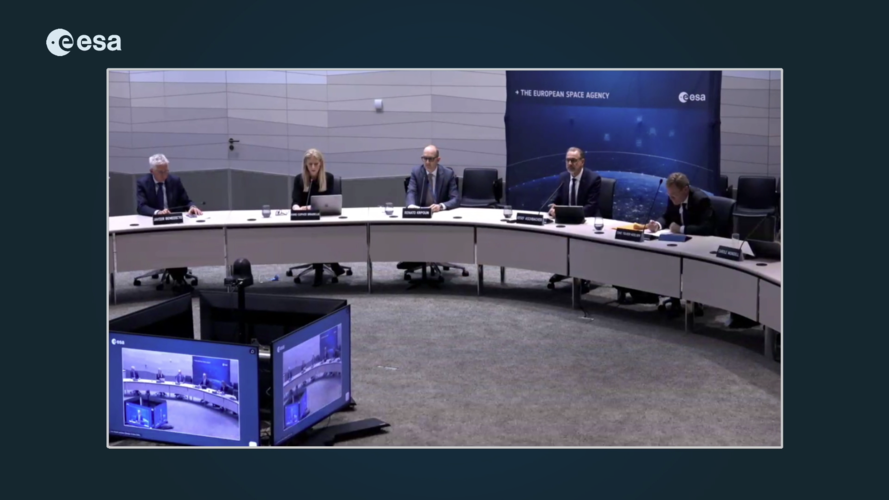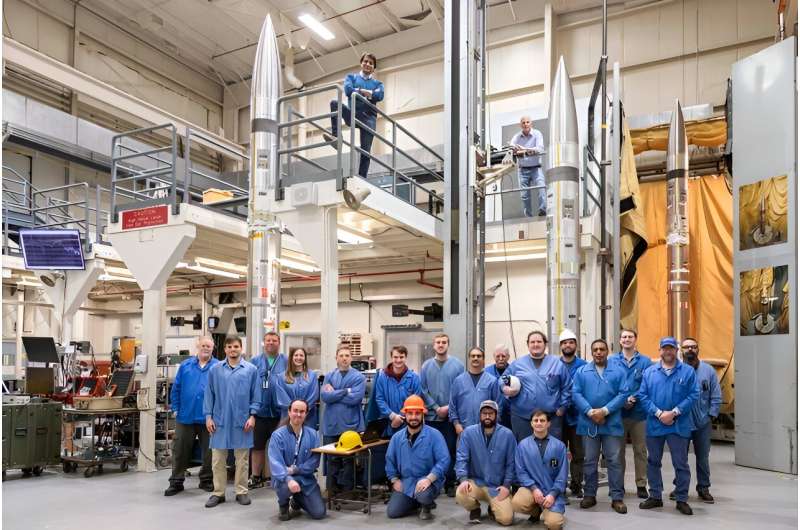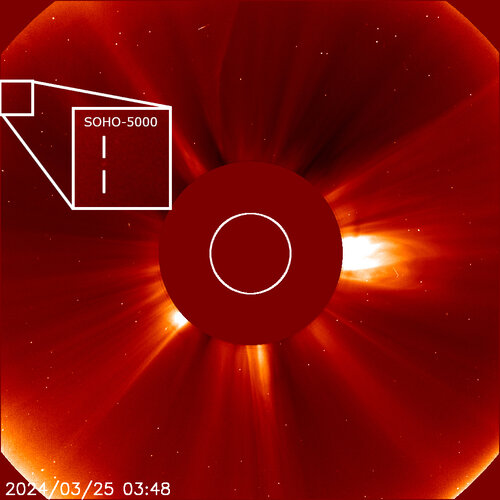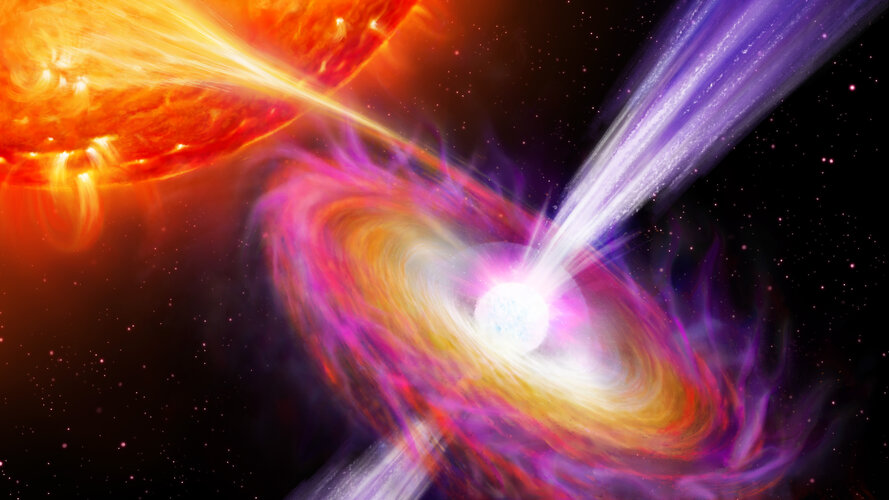
Copernical Team
Information session on the outcome of ESA's 323rd Council
 Video:
00:38:30
Video:
00:38:30
ESA Member States met in Paris, France, for the 323rd session of the ESA Council on 26 and 27 March 2024.
Watch the replay of the information session in which ESA Director General Josef Aschbacher and ESA Council Chair Renato Krpoun share the outcome of the meeting. They gave an update to media about ESA's vision for the European space sector by 2040 and the status of actions provided in the roadmap for the implementation of the Resolution on present and future European Space Transportation.
They also addressed the progress made in addressing critical challenges faced by ESA in preparation for the next Ministerial Council
NASA to launch sounding rockets into moon's shadow during solar eclipse

NASA will launch three sounding rockets during the total solar eclipse on April 8, 2024, to study how Earth's upper atmosphere is affected when sunlight momentarily dims over a portion of the planet.
The Atmospheric Perturbations around Eclipse Path (APEP) sounding rockets will launch from NASA's Wallops Flight Facility in Virginia to study the disturbances in the ionosphere created when the moon eclipses the sun. The sounding rockets had been previously launched and successfully recovered from White Sands Test Facility in New Mexico, during the October 2023 annular solar eclipse.
What is a 'worm moon' and does it still mark the start of spring?

The worm moon has risen. The final full moon of winter in the northern hemisphere appeared on March 25 and owes its name to Native Americans who noted winter's end by the trails of earthworms it illuminated on the newly thawed soil.
Common names of full moons generally come from seasonal animals, colors or crops: wolf moon, pink moon, harvest moon. But the worm moon may be losing its significance, as climate change leads to wetter summers and milder winters in much of the world. I've been an earthworm scientist for more than three decades, and, of late, I'm seeing signs of worms at the surface in months when they used to be inactive.
To track how the worm moon might be changing we can look at a particular earthworm species (Lumbricus terrestris, aka the dew worm, nightcrawler or lob worm) which is unusually easy to track. Also sometimes called the common earthworm, if you see a big worm in the garden, it's likely to be this species.
Most worms spend most of their lives underground, but the dew worm almost completely leaves its deep burrow, with tail tip left in, as it ventures on to the soil surface every night to feed on dead leaves.
Orbex patents Reusable Rocket Technology dubbed 'Petal Fold'
 Orbex has achieved a significant milestone in the advancement of space technology by securing a patent for its innovative REFLIGHT reusable rocket technology. The European Patent Office and the United States have both granted patents for this cutting-edge technology, marking a major leap forward in sustainable space exploration.
Designed specifically for micro-launcher rockets, such as Orb
Orbex has achieved a significant milestone in the advancement of space technology by securing a patent for its innovative REFLIGHT reusable rocket technology. The European Patent Office and the United States have both granted patents for this cutting-edge technology, marking a major leap forward in sustainable space exploration.
Designed specifically for micro-launcher rockets, such as Orb Radar journey to centre of Hera’s asteroid with Juventas CubeSat

A small, shoebox-sized spacecraft delivered to ESA’s Hera mission this week promises to make a giant leap forward in planetary science. Once deployed from the Hera spacecraft at the Didymos binary asteroid system, the Juventas CubeSat perform the first radar probe within an asteroid, peering deep into the heart of the Great-Pyramid-sized Dimorphos moonlet.
SOHO reaches 5000 comets
 Image:
Image:
A citizen scientist digging through data from the ESA/NASA Solar and Heliospheric Observatory has found the mission’s 5000th comet.
The tiny comet – indicated between the vertical lines in the inset – belongs to the ‘Marsden group’, named after the British astronomer Brian Marsden, who first recognised the group based on SOHO observations. Marsden group comets are thought to be pieces shed by the much bigger Comet 96P/Machholz, which SOHO observes as it passes close to the Sun every 5.3 years.
This 5000th comet was discovered by Hanjie Tan, an astronomy PhD student in Prague, Czechia. Hanjie has been comet hunting
Integral spots giant explosions feeding neutron star jets

ESA’s gamma-ray space telescope Integral has played a decisive role in capturing jets of matter being expelled into space at one-third the speed of light. The material and energy were liberated when huge explosions occurred on the surface of a neutron star. This world-first observation proved to be 'a perfect experiment' for exploring astrophysical jets of all descriptions.
European Scientists Unveil Detailed Mars Map Ahead of Rosalind Franklin Rover Mission
 In a major effort, European researchers have completed the most comprehensive geological survey of Mars' Oxia Planum, the designated landing site for the European Space Agency's (ESA) ambitious Rosalind Franklin rover. This map, crafted with four years of meticulous study, charts fifteen distinct geological units, setting the stage for the rover's exploratory mission aimed at uncovering the secr
In a major effort, European researchers have completed the most comprehensive geological survey of Mars' Oxia Planum, the designated landing site for the European Space Agency's (ESA) ambitious Rosalind Franklin rover. This map, crafted with four years of meticulous study, charts fifteen distinct geological units, setting the stage for the rover's exploratory mission aimed at uncovering the secr CADRE Rovers Complete Crucial Testing Phase Ahead of Lunar Mission
 In a significant advancement for autonomous space exploration, NASA's Cooperative Autonomous Distributed Robotic Exploration (CADRE) program has successfully completed a critical series of tests with its development model rovers at the Mars Yard of the Jet Propulsion Laboratory (JPL) in Southern California. The test, conducted in August 2023, showcased the rovers' ability to perform collaborativ
In a significant advancement for autonomous space exploration, NASA's Cooperative Autonomous Distributed Robotic Exploration (CADRE) program has successfully completed a critical series of tests with its development model rovers at the Mars Yard of the Jet Propulsion Laboratory (JPL) in Southern California. The test, conducted in August 2023, showcased the rovers' ability to perform collaborativ Antarctic Experiment Pursues Quantum Gravity Proof via Neutrino Analysis
 In an unprecedented effort to validate the existence of quantum gravity, researchers at the University of Copenhagen's Niels Bohr Institute have embarked on a large-scale Antarctic experiment. By monitoring neutrinos, nearly massless particles that travel undisturbed through space, scientists aim to bridge the gap between classical physics and quantum mechanics.
The experiment, utilizing t
In an unprecedented effort to validate the existence of quantum gravity, researchers at the University of Copenhagen's Niels Bohr Institute have embarked on a large-scale Antarctic experiment. By monitoring neutrinos, nearly massless particles that travel undisturbed through space, scientists aim to bridge the gap between classical physics and quantum mechanics.
The experiment, utilizing t 
